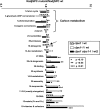ClpS1 is a conserved substrate selector for the chloroplast Clp protease system in Arabidopsis
- PMID: 23898032
- PMCID: PMC3723626
- DOI: 10.1105/tpc.113.112557
ClpS1 is a conserved substrate selector for the chloroplast Clp protease system in Arabidopsis
Abstract
Whereas the plastid caseinolytic peptidase (Clp) P protease system is essential for plant development, substrates and substrate selection mechanisms are unknown. Bacterial ClpS is involved in N-degron substrate selection and delivery to the ClpAP protease. Through phylogenetic analysis, we show that all angiosperms contain ClpS1 and some species also contain ClpS1-like protein(s). In silico analysis suggests that ClpS1 is the functional homolog of bacterial ClpS. We show that Arabidopsis thaliana ClpS1 interacts with plastid ClpC1,2 chaperones. The Arabidopsis ClpS1 null mutant (clps1) lacks a visible phenotype, and no genetic interactions with ClpC/D chaperone or ClpPR core mutants were observed. However, clps1, but not clpc1-1, has increased sensitivity to the translational elongation inhibitor chloramphenicol suggesting a link between translational capacity and ClpS1. Moreover, ClpS1 was upregulated in clpc1-1, and quantitative proteomics of clps1, clpc1, and clps1 clpc1 showed specific molecular phenotypes attributed to loss of ClpC1 or ClpS1. In particular, clps1 showed alteration of the tetrapyrrole pathway. Affinity purification identified eight candidate ClpS1 substrates, including plastid DNA repair proteins and Glu tRNA reductase, which is a control point for tetrapyrrole synthesis. ClpS1 interaction with five substrates strictly depended on two conserved ClpS1 residues involved in N-degron recognition. ClpS1 function, substrates, and substrate recognition mechanisms are discussed.
Figures












Similar articles
-
Discovery of a Unique Clp Component, ClpF, in Chloroplasts: A Proposed Binary ClpF-ClpS1 Adaptor Complex Functions in Substrate Recognition and Delivery.Plant Cell. 2015 Oct;27(10):2677-91. doi: 10.1105/tpc.15.00574. Epub 2015 Sep 29. Plant Cell. 2015. PMID: 26419670 Free PMC article.
-
In Vivo Trapping of Proteins Interacting with the Chloroplast CLPC1 Chaperone: Potential Substrates and Adaptors.J Proteome Res. 2019 Jun 7;18(6):2585-2600. doi: 10.1021/acs.jproteome.9b00112. Epub 2019 May 22. J Proteome Res. 2019. PMID: 31070379
-
Proteomics, phylogenetics, and coexpression analyses indicate novel interactions in the plastid CLP chaperone-protease system.J Biol Chem. 2022 Mar;298(3):101609. doi: 10.1016/j.jbc.2022.101609. Epub 2022 Jan 20. J Biol Chem. 2022. PMID: 35065075 Free PMC article.
-
Uvr motifs regulate the chloroplast Clp chaperone-protease system.Trends Plant Sci. 2025 Mar;30(3):269-282. doi: 10.1016/j.tplants.2024.09.015. Epub 2024 Oct 24. Trends Plant Sci. 2025. PMID: 39448301 Review.
-
The Clp protease system; a central component of the chloroplast protease network.Biochim Biophys Acta. 2011 Aug;1807(8):999-1011. doi: 10.1016/j.bbabio.2010.12.003. Epub 2010 Dec 15. Biochim Biophys Acta. 2011. PMID: 21167127 Review.
Cited by
-
Quantitative analysis of the chloroplast molecular chaperone ClpC/Hsp93 in Arabidopsis reveals new insights into its localization, interaction with the Clp proteolytic core, and functional importance.J Biol Chem. 2014 Apr 18;289(16):11318-11330. doi: 10.1074/jbc.M113.534552. Epub 2014 Mar 5. J Biol Chem. 2014. PMID: 24599948 Free PMC article.
-
Crystal structures reveal N-terminal Domain of Arabidopsis thaliana ClpD to be highly divergent from that of ClpC1.Sci Rep. 2017 Mar 13;7:44366. doi: 10.1038/srep44366. Sci Rep. 2017. PMID: 28287170 Free PMC article.
-
TaClpS1, negatively regulates wheat resistance against Puccinia striiformis f. sp. tritici.BMC Plant Biol. 2020 Dec 10;20(1):555. doi: 10.1186/s12870-020-02762-0. BMC Plant Biol. 2020. PMID: 33302867 Free PMC article.
-
Autocatalytic Processing and Substrate Specificity of Arabidopsis Chloroplast Glutamyl Peptidase.Plant Physiol. 2020 Sep;184(1):110-129. doi: 10.1104/pp.20.00752. Epub 2020 Jul 6. Plant Physiol. 2020. PMID: 32663165 Free PMC article.
-
Masks Start to Drop: Suppressor of MAX2 1-Like Proteins Reveal Their Many Faces.Front Plant Sci. 2022 May 12;13:887232. doi: 10.3389/fpls.2022.887232. eCollection 2022. Front Plant Sci. 2022. PMID: 35645992 Free PMC article. Review.
References
-
- Bischof S., Baerenfaller K., Wildhaber T., Troesch R., Vidi P.A., Roschitzki B., Hirsch-Hoffmann M., Hennig L., Kessler F., Gruissem W., Baginsky S. (2011). Plastid proteome assembly without Toc159: Photosynthetic protein import and accumulation of N-acetylated plastid precursor proteins. Plant Cell 23: 3911–3928 - PMC - PubMed
MeSH terms
Substances
LinkOut - more resources
Full Text Sources
Other Literature Sources
Molecular Biology Databases
Miscellaneous

